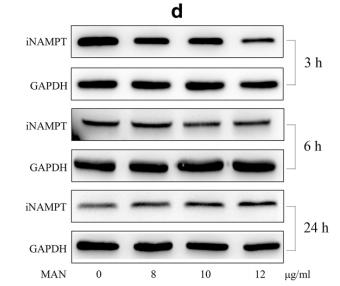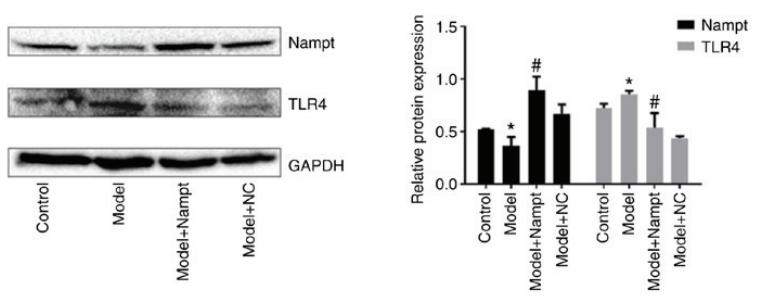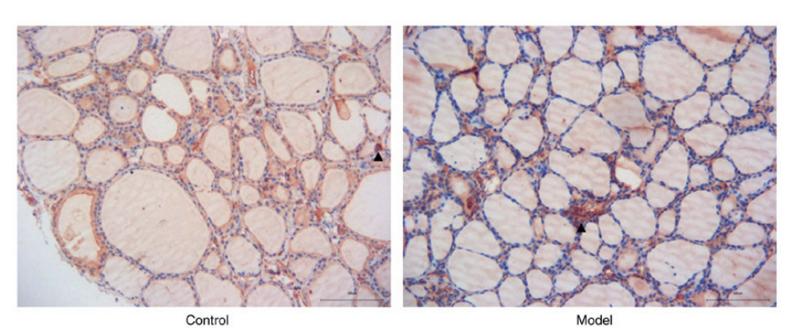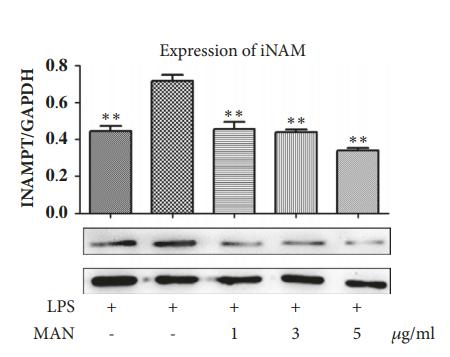NAMPT Antibody - #DF6059
| Product: | NAMPT Antibody |
| Catalog: | DF6059 |
| Description: | Rabbit polyclonal antibody to NAMPT |
| Application: | WB IHC IF/ICC |
| Reactivity: | Human, Mouse, Rat |
| Prediction: | Pig, Bovine, Horse, Sheep, Rabbit, Dog |
| Mol.Wt.: | 52kDa; 56kD(Calculated). |
| Uniprot: | P43490 |
| RRID: | AB_2838028 |
Related Downloads
Protocols
Product Info
*The optimal dilutions should be determined by the end user.
*Tips:
WB: For western blot detection of denatured protein samples. IHC: For immunohistochemical detection of paraffin sections (IHC-p) or frozen sections (IHC-f) of tissue samples. IF/ICC: For immunofluorescence detection of cell samples. ELISA(peptide): For ELISA detection of antigenic peptide.
Cite Format: Affinity Biosciences Cat# DF6059, RRID:AB_2838028.
Fold/Unfold
1110035O14Rik; AI314458; AI480535; DKFZP666B131; EC 2.4.2.12; MGC117256; NAmPRTase; Nampt; NAMPT_HUMAN; Nicotinamide phosphoribosyltransferase; PBEF 1; PBEF; PBEF1; Pre B cell colony enhancing factor 1; Pre B cell colony enhancing factor; Pre B cell enhancing factor; Pre-B cell-enhancing factor; Pre-B-cell colony-enhancing factor 1; VF; Visfatin;
Immunogens
Expressed in large amounts in bone marrow, liver tissue, and muscle. Also present in heart, placenta, lung, and kidney tissues.
- P43490 NAMPT_HUMAN:
- Protein BLAST With
- NCBI/
- ExPASy/
- Uniprot
MNPAAEAEFNILLATDSYKVTHYKQYPPNTSKVYSYFECREKKTENSKLRKVKYEETVFYGLQYILNKYLKGKVVTKEKIQEAKDVYKEHFQDDVFNEKGWNYILEKYDGHLPIEIKAVPEGFVIPRGNVLFTVENTDPECYWLTNWIETILVQSWYPITVATNSREQKKILAKYLLETSGNLDGLEYKLHDFGYRGVSSQETAGIGASAHLVNFKGTDTVAGLALIKKYYGTKDPVPGYSVPAAEHSTITAWGKDHEKDAFEHIVTQFSSVPVSVVSDSYDIYNACEKIWGEDLRHLIVSRSTQAPLIIRPDSGNPLDTVLKVLEILGKKFPVTENSKGYKLLPPYLRVIQGDGVDINTLQEIVEGMKQKMWSIENIAFGSGGGLLQKLTRDLLNCSFKCSYVVTNGLGINVFKDPVADPNKRSKKGRLSLHRTPAGNFVTLEEGKGDLEEYGQDLLHTVFKNGKVTKSYSFDEIRKNAQLNIELEAAHH
Predictions
Score>80(red) has high confidence and is suggested to be used for WB detection. *The prediction model is mainly based on the alignment of immunogen sequences, the results are for reference only, not as the basis of quality assurance.
High(score>80) Medium(80>score>50) Low(score<50) No confidence
PTMs - P43490 As Substrate
| Site | PTM Type | Enzyme | Source |
|---|---|---|---|
| M1 | Acetylation | Uniprot | |
| T15 | Phosphorylation | Uniprot | |
| S17 | Phosphorylation | Uniprot | |
| Y18 | Phosphorylation | Uniprot | |
| K24 | Ubiquitination | Uniprot | |
| Y26 | Phosphorylation | Uniprot | |
| Y34 | Phosphorylation | Uniprot | |
| Y36 | Phosphorylation | Uniprot | |
| K48 | Ubiquitination | Uniprot | |
| Y54 | Phosphorylation | Uniprot | |
| T57 | Phosphorylation | Uniprot | |
| Y60 | Phosphorylation | Uniprot | |
| Y64 | Phosphorylation | Uniprot | |
| Y69 | Phosphorylation | Uniprot | |
| K84 | Ubiquitination | Uniprot | |
| Y87 | Phosphorylation | Uniprot | |
| K88 | Ubiquitination | Uniprot | |
| K99 | Ubiquitination | Uniprot | |
| K107 | Ubiquitination | Uniprot | |
| K117 | Ubiquitination | Uniprot | |
| K174 | Ubiquitination | Uniprot | |
| Y175 | Phosphorylation | Uniprot | |
| Y188 | Phosphorylation | Uniprot | |
| K189 | Ubiquitination | Uniprot | |
| R196 | Methylation | Uniprot | |
| K228 | Ubiquitination | Uniprot | |
| K229 | Ubiquitination | Uniprot | |
| K234 | Ubiquitination | Uniprot | |
| S241 | Phosphorylation | Uniprot | |
| K255 | Ubiquitination | Uniprot | |
| K259 | Ubiquitination | Uniprot | |
| S314 | Phosphorylation | Uniprot | |
| K330 | Ubiquitination | Uniprot | |
| K331 | Ubiquitination | Uniprot | |
| T335 | Phosphorylation | Uniprot | |
| S338 | Phosphorylation | Uniprot | |
| K339 | Ubiquitination | Uniprot | |
| K342 | Ubiquitination | Uniprot | |
| K369 | Acetylation | Uniprot | |
| K369 | Ubiquitination | Uniprot | |
| K371 | Ubiquitination | Uniprot | |
| S374 | Phosphorylation | Uniprot | |
| S382 | Phosphorylation | Uniprot | |
| K389 | Ubiquitination | Uniprot | |
| S398 | Phosphorylation | Uniprot | |
| Y403 | Phosphorylation | Uniprot | |
| K415 | Acetylation | Uniprot | |
| K423 | Acetylation | Uniprot | |
| K423 | Ubiquitination | Uniprot | |
| S431 | Phosphorylation | Uniprot | |
| T435 | Phosphorylation | Uniprot | |
| K447 | Ubiquitination | Uniprot | |
| Y453 | Phosphorylation | Uniprot | |
| K469 | Ubiquitination | Uniprot | |
| S470 | Phosphorylation | Uniprot | |
| S472 | Phosphorylation | Uniprot |
Research Backgrounds
Catalyzes the condensation of nicotinamide with 5-phosphoribosyl-1-pyrophosphate to yield nicotinamide mononucleotide, an intermediate in the biosynthesis of NAD. It is the rate limiting component in the mammalian NAD biosynthesis pathway. The secreted form behaves both as a cytokine with immunomodulating properties and an adipokine with anti-diabetic properties, it has no enzymatic activity, partly because of lack of activation by ATP, which has a low level in extracellular space and plasma. Plays a role in the modulation of circadian clock function. NAMPT-dependent oscillatory production of NAD regulates oscillation of clock target gene expression by releasing the core clock component: CLOCK-ARNTL/BMAL1 heterodimer from NAD-dependent SIRT1-mediated suppression (By similarity).
Nucleus. Cytoplasm. Secreted.
Note: Under non-inflammatory conditions, visfatin predominantly exhibits a granular pattern within the nucleus. Secreted by endothelial cells upon IL-1beta stimulation. Abundantly secreted in milk, reaching 100-fold higher concentrations compared to maternal serum.
Expressed in large amounts in bone marrow, liver tissue, and muscle. Also present in heart, placenta, lung, and kidney tissues.
Homodimer.
Belongs to the NAPRTase family.
Research Fields
· Metabolism > Metabolism of cofactors and vitamins > Nicotinate and nicotinamide metabolism.
· Metabolism > Global and overview maps > Metabolic pathways.
· Organismal Systems > Immune system > NOD-like receptor signaling pathway. (View pathway)
References
Application: WB Species: rat Sample: HFLS-RA cells
Application: IHC Species: rat Sample: synovium
Application: IHC Species: rat Sample: fat pad
Application: WB Species: rat Sample: thyroid
Application: IHC Species: rat Sample: thyroid
Application: WB Species: rat Sample: RAW 264.7 cells
Restrictive clause
Affinity Biosciences tests all products strictly. Citations are provided as a resource for additional applications that have not been validated by Affinity Biosciences. Please choose the appropriate format for each application and consult Materials and Methods sections for additional details about the use of any product in these publications.
For Research Use Only.
Not for use in diagnostic or therapeutic procedures. Not for resale. Not for distribution without written consent. Affinity Biosciences will not be held responsible for patent infringement or other violations that may occur with the use of our products. Affinity Biosciences, Affinity Biosciences Logo and all other trademarks are the property of Affinity Biosciences LTD.






